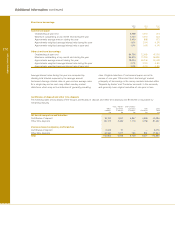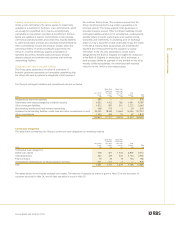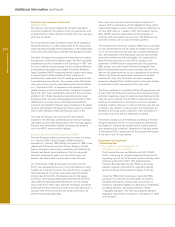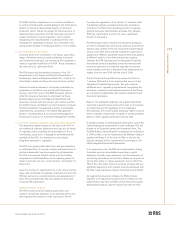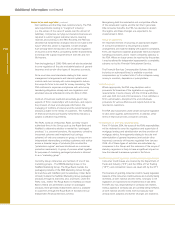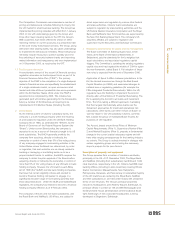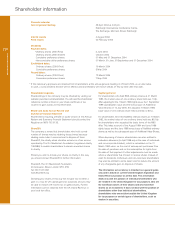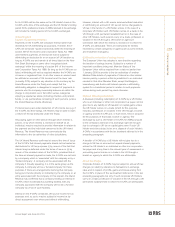RBS 2003 Annual Report Download - page 219
Download and view the complete annual report
Please find page 219 of the 2003 RBS annual report below. You can navigate through the pages in the report by either clicking on the pages listed below, or by using the keyword search tool below to find specific information within the annual report.
Annual Report and Accounts 2003
217
Additional information
The Competition Commission recommended a number of
pricing and behavioural remedies following its inquiry into
the UK market for small business banking. The Group has
implemented the pricing remedies with effect from 1 January
2003. In line with undertakings given by the Group and
three other major clearing banks to the OFT, the Group’s
SME customers have been offered the choice of either
receiving interest on current accounts at a prescribed rate
or free core money transmission services. The Group, along
with seven other clearing banks, has also given undertakings
to implement the behavioural remedies. These behavioural
remedies include measures to achieve speedy and error
free switching of accounts between banks and improving
market information and transparency and were implemented
on 31 December 2003, as required by the OFT.
1.7 The European dimension
A considerable amount of the recent UK financial services
regulation emanates via the European Union as part of its
Financial Services Action Plan (“FSAP”). The primary
objective of the FSAP is the completion of a single European
market in financial services and specifically the establishment
of a single wholesale market, an open and secure retail
market and state-of-the-art prudential rules and supervision
within the EU Member States. Work under the FSAP is
expected to be completed by 2005. This initiative has
generated (and will continue generating, for the foreseeable
future) a number of EU Directives all requiring to be
implemented in EC Member States (including the UK).
2 United States
As the indirect parent of Citizens’ subsidiary banks, the
company is a bank holding company within the meaning
of, and subject to regulation under, the US Bank Holding
Company Act of 1956, as amended (the “BHCA”), by the
Board of Governors of the Federal Reserve System (the
“Board”). Under current Board policy, the company is
expected to act as a source of financial strength to its US
bank subsidiaries. The BHCA generally prohibits the
company from acquiring, directly or indirectly, the
ownership or control of more than 5% of the voting shares
of any company engaged in non-banking activities in the
United States unless the Board has determined, by order
or regulation, that such activities are so closely related to
banking or managing or controlling banks as to be a
proper incident thereto. In addition, the BHCA requires the
company to obtain the prior approval of the Board before
acquiring, directly or indirectly, the ownership or control of
more than 5% of the voting shares of any US bank or bank
holding company. However, the US Gramm-Leach-Bliley
Act of 1999 (the "GLBA") permits bank holding companies
that have met certain eligibility criteria and elected to
become 'financial holding companies' to engage in a
significantly broader range of non-banking activities than
those described above. Under the GLBA and related Board
regulations, the company has elected to become a financial
holding company effective as of 9 February 2004.
The company’s US bank and non-bank subsidiaries, and
the Royal Bank and NatWest’s US offices, are subject to
direct supervision and regulation by various other federal
and state authorities. Citizens’ bank subsidiaries are
subject to regulation by state banking authorities and the
US Federal Deposit Insurance Corporation and the Royal
Bank and NatWest’s New York branches are supervised by
the New York Banking Department. The company’s US
securities affiliates are subject to regulation and
supervision by the Securities and Exchange Commission.
3 Regulatory developments for capital and risk management
The Basel Committee on Banking Supervision, which
meets at the Bank of International Settlements in
Switzerland, sets the standards for firm’s weighted risk
asset calculations and associated regulatory capital
triggers. This Committee is updating the existing regulatory
capital rules and has targeted the middle of 2004 to agree
the new framework, called Basel II. Full adoption of these
new rules is expected from the end of December 2006.
Application of Basel II differs between jurisdictions. In the
EU, the Accord becomes law through the Risk Based
Capital Directive (or CAD3) and associated changes to
national laws or regulatory guidelines (for example the
FSAs Integrated Prudential Sourcebook). Within the US,
regulators have the flexibility to implement the Accord
directly, after a Final Notice of Prudential Rulemaking. The
EU is applying the Accord to all banks and investment
firms. The US is taking a different approach, mandating
that their largest internationally active banks use the
‘Advanced’ approaches for credit and operational risk
calculations; other banks can either remain on Basel l or
‘opt-into’ Basel ll. Our US subsidiary, Citizens, currently
falls outside the group of mandated Basel ll banks for
purposes of US regulation.
The Accord, based around three Pillars of Minimum
Capital Requirements (Pillar 1), Supervisory Review (Pillar
2) and Market Discipline (Pillar 3), presents a fundamental
change to the current capital adequacy regime and will
have wide ranging consequences for the banking industry
as a whole. The Group is actively involved in dialogue with
various regulatory groups and is taking the necessary
steps to prepare for the new Accord.
Description of property and equipment
The Group operates from a number of locations worldwide,
principally in the UK. At 31 December 2003, The Royal Bank
and NatWest (including their subsidiaries) had 636 and 1,634
retail branches, respectively, in the UK. Citizens had 866 retail
banking offices (including in-store branches) covering Rhode
Island, Connecticut, Massachusetts, New Hampshire,
Pennsylvania, Delaware, and New Jersey. A substantial majority
of the UK branches are owned by the Royal Bank, NatWest
and their subsidiaries or are held under leases with unexpired
terms of over 50 years. The Group’s principal properties
include its headquarters at St Andrew Square, Edinburgh, its
principal offices in London at 135 and 280 Bishopsgate and
the Drummond House administration centre located at South
Gyle, Edinburgh. A new corporate headquarters is being
developed at Gogarburn, Edinburgh.





